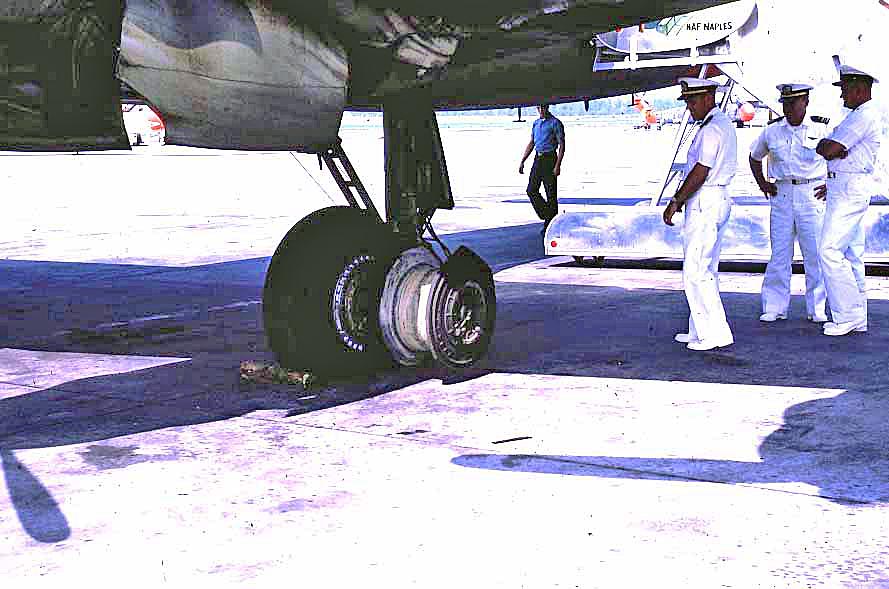|
|
Next Page
Go Direct to Ops Summaries and Prop Wash Page (1),
(2),
(3),
(4),
(5),
(7)
(8),
(9),
(10),
(11),
(12),
(13),
(14),
(15),
(16),
(17),
(18),
(19),
(20),
(21),
(22),
(23),
(24),
(25),
(26),
(27),
(28),
(29),
(30),
(31),
(32),
(33),
(34),
(35),
(36),
(37),
(38),
Return to
Ops Summaries and Prop Wash Page One
Return to
Scrapbook Page One
Return to Home
Page
The following articles were
contributed by former members of VR-24. Anyone who has photos, stories,
and material they wish to share is encouraged to send them to
Dick Prather, editor of the
VR-24 website.
|
Tight Squeeze
Jim Touhey reports on
another flight, for which he received short notice. The flight
itinerary called for departure from Port Lyautey on 18 October 1952,
with the first leg of the trip to Naples, and the second to Catania,
Sicily. Upon arrival at Catania, the crew found a group of Marines
awaiting them. The mission was to deliver not only the Marines but
their jeep as well, to a field near Udine, Italy, sixty miles from
Trieste, which was first of many Cold War "hot spots".
Boarding the Marines would be simple. They would climb the plane’s
boarding ladder. Loading the jeep would be another matter.
Fortunately, the Marines brought their own ramps with which to load the
jeep. Unfortunately, the jeep, or its fixed equipment, was too tall to
go through the plane’s door. The loading evolution was temporarily
halted while alternatives were considered. Then someone thought of
letting enough air out of the jeep tires for it to fit through the door.
That solved the immediate problem, but given a cabin floor of no more
than nine feet in width, turning the jeep as it rolled from the ramp
into the side door of the cabin would also have been a problem. Jim
does not say how they managed it, but the crew most likely used muscle
to skid the front of the jeep around to align it with the axis of the
aircraft. Once the jeep was tied-down forward in the cabin, the ramps
were also brought aboard and strapped to the deck.
The crew then flew to Udine where they landed on a WWII-era field,
complete with a runway made of perforated interlocking steel planking,
otherwise known as Marston matting. By the time they reversed the
loading process and were ready to depart, it had gotten dark. Ordinarily,
that was not an issue, but it was in this case since no one had seen fit
to install runway lights at the field. Undaunted, the crew arranged with
the Marines to park two jeeps so that their headlights shined across the
far end of the darkened runway. Using the jeep lights as a reference,
the pilots of the R5D lined up and took off. Although exciting, at
least for some, operating in areas with minimal to non-existent facilities
and support was part and parcel to accomplishing the squadron’s various
missions.
|
The Missing Tire
It was not uncommon for VR-24 flight crews to resort to
unusual methods in order to complete a mission or get the plane back home.
Roman Ballock contributed the following account of one R5D crew’s
somewhat radical solution to a problem encountered while "on the road".
The flight was scheduled to be a "round-robin" out of Naples to deliver
mail and cargo to Aivano, Italy where a few U.S. Sixth Fleet ships were
in port. Upon landing at the destination field near the city of Venice,
the outboard tire on the port (left) main-mount blew out. After getting
to the terminal and unloading the plane, the crew found that there was
no support such as spare tires, aircraft jacks, or tools of any kind.
The situation was not unusual for many of the fields into which VR-24
delivered goods and people. However, the crew’s solution was.
Undeterred by such minor details, and no doubt unwilling to wait for
assistance to be flown in, the crew elected to take matters into their
own hands. Using their personal survival knives and wire cutters from
the onboard toolbox, the ingenious crewmen went at the carcass of the
blown tire and cut it off of the rim.
Removal of the damaged tire was a serious safety matter. At the rotational
speeds reached immediately before takeoff and after landing, the blown
tire would likely disintegrate, flinging pieces and causing damage to
the aircraft itself.
A normal takeoff was made, with light fuel load, from Aviano. That was
the easy part. Landing the big airplane minus the prescribed number of
tires would be a bit trickier. Roman does not recall the pilots on that
flight, but clearly remembers the landing back at NAF Capodichinno.
Putting the plane down on the starboard main-mount, the pilot held the
left wheel off until the loss of flying speed forced him to ease it onto
the runway. No sweat, discounting the crew’s collective pucker factor!
As shown in the photo below, the plane’s unusual, if not unique, landing
gear configuration was cause of some wonderment among those meeting the
aircraft and crew at Naples.
|
Top of Page
Next Page
Go Direct to Ops Summaries and Prop Wash Page (1),
(2),
(3),
(4),
(5),
(7)
(8),
(9),
(10),
(11),
(12),
(13),
(14),
(15),
(16),
(17),
(18),
(19),
(20),
(21),
(22),
(23),
(24),
(25),
(26),
(27),
(28),
(29),
(30),
(31),
(32),
(33),
(34),
(35),
(36),
(37),
(38),
Return to
Ops Summaries and Prop Wash Page One
Return to
Scrapbook Page One
Return to Home
Page
Copyright © 2002 VR-24
Association
